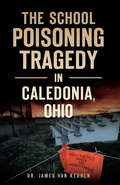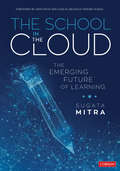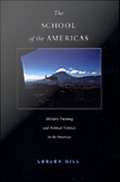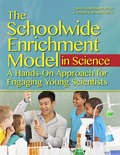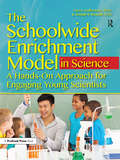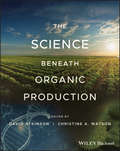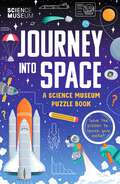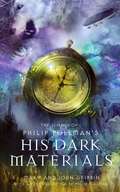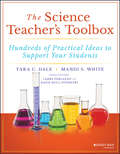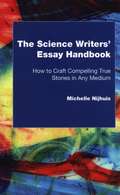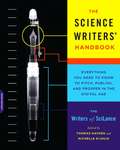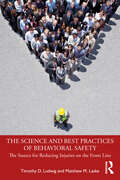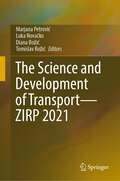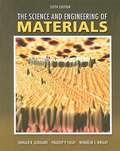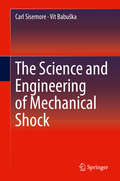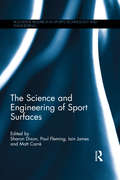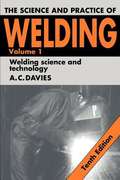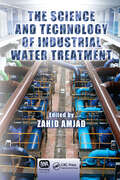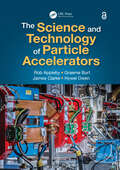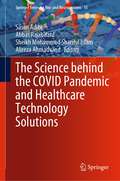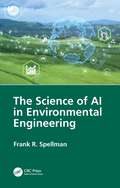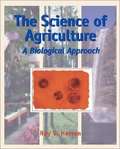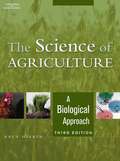- Table View
- List View
The School Poisoning Tragedy in Caledonia, Ohio
by Dr. James KeurenIn the early 1960s, the River Valley Local School District built its middle school, its high school and its athletic fields in the former Marion Engineer Depot. During World War II, the depot had used the land for heavy equipment rehab, military artillery practice, materials storage, burial of construction debris and burning of waste materials and fuels. In 1997, a River Valley High School nurse grew concerned about the high rate of leukemia and other cancers in graduates. Then a stunning news report announcing a 122 percent increase in death rates over thirty years in the Marion area sparked an investigation. Was the land to blame? The question of what may have been known about the contaminates on the school grounds sent shock waves through the community that still linger today.
The School in the Cloud: The Emerging Future of Learning (Corwin Teaching Essentials)
by Sugata MitraThe Science and the Story of the Future of Learning Educators have been trying to harness the "promise" of technology in education for decades, to no avail, but we have learned that children in groups—when given access to the Internet—can learn anything by themselves. In this groundbreaking book, you’ll glimpse the emerging future of learning with technology. It turns out the promise isn’t in the technology itself; it’s in the self-directed learning of the children who use it. In 1999, Sugata Mitra conducted the famous "Hole in the Wall" experiment that inspired three TED Talks and earned him the first million-dollar TED prize for research in 2013. Since then, he has conducted new research around self-organized learning environments (SOLE), building "Schools in the Cloud" all over the world. This new book shares the results of this research and offers • Examples of thriving Schools in the Cloud in unlikely places • Mitra’s predictions on the future of learning • How to design assessments for self-organizing learning • How to build your own School in the Cloud • Clips from the documentary, The School in the Cloud Discover the future of learning by digging deep into Mitra’s thought-provoking experiences, examples, and vision.
The School in the Cloud: The Emerging Future of Learning (Corwin Teaching Essentials)
by Sugata MitraThe Science and the Story of the Future of Learning Educators have been trying to harness the "promise" of technology in education for decades, to no avail, but we have learned that children in groups—when given access to the Internet—can learn anything by themselves. In this groundbreaking book, you’ll glimpse the emerging future of learning with technology. It turns out the promise isn’t in the technology itself; it’s in the self-directed learning of the children who use it. In 1999, Sugata Mitra conducted the famous "Hole in the Wall" experiment that inspired three TED Talks and earned him the first million-dollar TED prize for research in 2013. Since then, he has conducted new research around self-organized learning environments (SOLE), building "Schools in the Cloud" all over the world. This new book shares the results of this research and offers • Examples of thriving Schools in the Cloud in unlikely places • Mitra’s predictions on the future of learning • How to design assessments for self-organizing learning • How to build your own School in the Cloud • Clips from the documentary, The School in the Cloud Discover the future of learning by digging deep into Mitra’s thought-provoking experiences, examples, and vision.
The School of the Americas: Military Training and Political Violence in the Americas
by Lesley GillLocated at Fort Benning in Columbus, Georgia, the School of the Americas (soa) is a U. S. Army center that has trained more than sixty thousand soldiers and police, mostly from Latin America, in counterinsurgency and combat-related skills since it was founded in 1946. So widely documented is the participation of the School's graduates in torture, murder, and political repression throughout Latin America that in 2001 the School officially changed its name to the Western Hemisphere Institute for Security Cooperation. Lesley Gill goes behind the faade and presents a comprehensive portrait of the School of the Americas. Talking to a retired Colombian general accused by international human rights organizations of terrible crimes, sitting in on classes, accompanying soa students and their families to an upscale local mall, listening to coca farmers in Colombia and Bolivia, conversing with anti-soa activists in the cramped office of the School of the Americas Watch--Gill exposes the School's institutionalization of state-sponsored violence, the havoc it has wrought in Latin America, and the strategies used by activists seeking to curtail it. Based on her unprecedented level of access to the School of the Americas, Gill describes the School's mission and training methods and reveals how its students, alumni, and officers perceive themselves in relation to the dirty wars that have raged across Latin America. Assessing the School's role in U. S. empire-building, she shows how Latin America's brightest and most ambitious military officers are indoctrinated into a stark good-versus-evil worldview, seduced by consumer society and the "American dream," and enlisted as proxies in Washington's war against drugs and "subversion. "
The Schoolwide Enrichment Model in Science
by Joseph Renzulli Nancy HeilbronnerGrounded in decades of research, the Schoolwide Enrichment Model (SEM) has been successfully implemented at hundreds of schools across the world. Now, The Schoolwide Enrichment Model in Science: A Hands-on Approach for Engaging Young Scientists takes high-engagement learning one step further by applying SEM teaching strategies to the science curriculum. In this book, teachers learn how to engage students and to teach the skills needed to complete meaningful, in-depth investigations in science. Activities are connected to the Next Generation Science Standards (NGSS) and current policy recommendations calling for the meaningful integration of technology and promoting thinking and doing like young scientists over rote memorization. Easy to read and use, the book incorporates many practical suggestions, as well as reproducible student and teacher handouts.
The Schoolwide Enrichment Model in Science: A Hands-On Approach for Engaging Young Scientists
by Nancy L. HeilbronnerGrounded in decades of research, the Schoolwide Enrichment Model (SEM) has been successfully implemented at hundreds of schools across the world. Now, The Schoolwide Enrichment Model in Science: A Hands-on Approach for Engaging Young Scientists takes high-engagement learning one step further by applying SEM teaching strategies to the science curriculum. In this book, teachers learn how to engage students and to teach the skills needed to complete meaningful, in-depth investigations in science. Activities are connected to the Next Generation Science Standards (NGSS) and current policy recommendations calling for the meaningful integration of technology and promoting thinking and doing like young scientists over rote memorization. Easy to read and use, the book incorporates many practical suggestions, as well as reproducible student and teacher handouts.
The Science Beneath Organic Production
by Christine A. Watson David AtkinsonA groundbreaking book that addresses the science that underpins organic agriculture and horticulture and its impact upon the management of organic systems With contributions from noted experts in the field, Organic Agriculture explores the cultural context of food production and examines the historical aspects, economic implications, and key scientific elements that underpin organic crop production. The book shows how a science-based approach to organic farming is grounded in history and elements of the social sciences as well as the more traditional areas of physics, chemistry and biology. Organic Agriculture offers a detailed explanation of the differences between organic systems and other approaches, answering questions about crop production and protection, crop rotations, soil health, biodiversity and the use of genetic resources. The authors identify current gaps in our understanding of the topic and discuss how organic farming research may be better accomplished in the future. This important book: Explores the science that underpins organic farming Contains illustrative case studies from around the world Examines organic agriculture’s philosophical roots and its socio-economic context Written for scientists and students of agriculture and horticulture, this book covers the issues linked to the use of science by organic producers and identifies key elements in the production of food.
The Science Museum Puzzle Book: Journey Into Space
by The Science MuseumAre you ready to become an astronaut? Then prepare for lift off with The Science Museum Puzzle Book, a unique puzzle book to launch your exploration of space.Embark on your very own astronaut training program; engineer your own rocket and blast off to explore other planets to find what might be out there, all the while discovering the history of space exploration and the pioneering men and women who led us there.From Galileo inventing the first telescope, to the fascinating 20th century space race, all the way up to the cutting-edge research and missions being done to this day, this book is stuffed with essential space facts and history as well as mind-bending puzzles.From codebreaking and brainteasers to word riddles and language puzzles, this is the perfect gift to challenge any budding space explorer.This is an adventure you don't want to miss!
The Science Of Philip Pullman's His Dark Materials
by John Gribbin Mary GribbinPhilip Pullman's His Dark Materials trilogy is renowned for its mystery and magic. What's the truth behind it all? Is the golden compass actually based in science? How does the subtle knife cut through anything? Could there be a bomb like the one made with Lyra's hair? How do the Gallivespians'lodestone resonators really work? And, of course, what are the Dark Materials? Drawing on string theory and spacetime, quantum physics and chaos theory, award-winning science writers Mary and John Gribbin reveal the real science behind Philip Pullman's bestselling fantasy trilogy in entertaining and crystal-clear prose. "From the Hardcover edition. "
The Science Teacher's Toolbox: Hundreds of Practical Ideas to Support Your Students (The Teacher's Toolbox Series)
by Tara C. Dale Mandi S. WhiteA winning educational formula of engaging lessons and powerful strategies for science teachers in numerous classroom settings The Teacher’s Toolbox series is an innovative, research-based resource providing teachers with instructional strategies for students of all levels and abilities. Each book in the collection focuses on a specific content area. Clear, concise guidance enables teachers to quickly integrate low-prep, high-value lessons and strategies in their middle school and high school classrooms. Every strategy follows a practical, how-to format established by the series editors. The Science Teacher's Toolbox is a classroom-tested resource offering hundreds of accessible, student-friendly lessons and strategies that can be implemented in a variety of educational settings. Concise chapters fully explain the research basis, necessary technology, Next Generation Science Standards correlation, and implementation of each lesson and strategy. Favoring a hands-on approach, this bookprovides step-by-step instructions that help teachers to apply their new skills and knowledge in their classrooms immediately. Lessons cover topics such as setting up labs, conducting experiments, using graphs, analyzing data, writing lab reports, incorporating technology, assessing student learning, teaching all-ability students, and much more. This book enables science teachers to: Understand how each strategy works in the classroom and avoid common mistakes Promote culturally responsive classrooms Activate and enhance prior knowledge Bring fresh and engaging activities into the classroom and the science lab Written by respected authors and educators, The Science Teacher's Toolbox: Hundreds of Practical Ideas to Support Your Students is an invaluable aid for upper elementary, middle school, and high school science educators as well those in teacher education programs and staff development professionals.
The Science Writers' Essay Handbook: How To Craft Compelling True Stories In Any Medium
by Michelle NijhuisThough the essay form is more than four centuries old, it's perfectly suited to the digital age--and to science writing. The Science Writers' Essay Handbook will show you how to: <p><p>* Recognize and develop essay ideas * Research and report for the essay form <p>* Organize your material before you write<p> * Develop a distinctive authorial voice <p>* Revise and polish your essays for publication <p>* Apply your essay-writing skills to stories of all kinds, from magazine features to multimedia productions to social-media posts <p> No matter what kind of science storyteller you are, The Science Writers' Essay Handbook will give you new tools to bring out the best in your work.
The Science Writers' Handbook: Everything You Need to Know to Pitch, Publish, and Prosper in the Digital Age
by Thomas Hayden Michelle NijhuisPopular science writing has exploded in the past decade, both in print and online. Who better to guide writers striving to succeed in the profession than a group of award-winning independent journalists with a combined total of 225 years of experience? <P><P>From Thomas Hayden’s chapter on the perfect pitch to Emma Maris’s advice on book proposals to Mark Schrope’s essential information on contracts, the members of SciLance give writers of all experience levels the practical information they need to succeed, as either a staffer or a freelancer. Going beyond craft, The Science Writer’s Handbook also tackles issues such as creating productive office space, balancing work and family, and finding lasting career satisfaction. It is the ultimate guide for anyone looking to prosper as a science writer in the new era of publishing.
The Science and Best Practices of Behavioral Safety: The Source for Reducing Injuries on the Front Line
by Timothy D. Ludwig Matthew M. LaskeThis book presents the scientific principles and real-world best practices of behavioral safety, one of the most mature and impactful applications of behavioral science to reduce injuries in industrial workplaces. The authors review the core principles of behavioral science and their application to modern safety processes. Process components are discussed in detail, including risk analysis and pinpointing, direct observation, performance feedback, reinforcing engagement, trending and functional analysis, behavior change interventions, and program evaluation. Discussions are complemented by industry best-practice case studies from world-class behavioral safety programs accredited by the Cambridge Center for Behavioral Studies (CCBS), which provide compelling evidence of the effectiveness of these behavioral science principles in reducing injury. The Science and Best Practices of Behavioral Safety is essential reading for safety professionals, process safety engineers, and leaders in companies who have implemented, or are considering implementing, behavioral safety; or as an aid to learning more about the scientific background behind effective and practical safety practices. Researchers, expert consultants, and students who are already familiar with the practice will also find the book a valuable source to further develop their expertise.
The Science and Development of Transport—ZIRP 2021
by Marjana Petrović Luka Novačko Diana Božić Tomislav RožićThis monograph presents the original scientific manuscripts submitted for publication at the International Conference - The Science and Development of Transport (ZIRP 2021), organized by the University of Zagreb, Faculty of Transport and Traffic Sciences, Zagreb, Croatia. The Conference takes place in Šibenik, Croatia, from 30th September until 1st October 2021, aiming to bring together the scientists and the practitioners by putting forward innovative solutions available to everyone. This monograph presents the newest scientific research, case studies, and best practices in the field of transport and logistics. In addition to the main topics, many relevant manuscripts in the field of transport and logistics have been presented, such as sustainable urban mobility and logistics, safety and policy, data science, process automation, inventory forecasting, improving competitiveness in the transport and logistics services market and raising customer satisfaction. The monograph will be of interest for the experienced researchers, professionals as well as Ph.D. students in the field of transport and logistics
The Science and Engineering of Materials
by Donald R. Askeland Pradeep P. Fulay Wendelin J. WrightThis text provides an understanding of the relationship between structure, processing, and properties of materials. By selecting the appropriate topics from this wealth of material, instructors can emphasize materials, provide a general overview, concentrate on mechanical behavior, or focus on physical properties. Since the book has more material than is needed for a one-semester course, students will also have a useful reference for subsequent courses in manufacturing, materials, design, or materials selection.
The Science and Engineering of Mechanical Shock
by Carl Sisemore Vít BabuškaThis book fills a unique position in the literature as a dedicated mechanical shock analysis book. Because shock events can be extremely damaging, mechanical shock is an important topic for engineers to understand. This book provides the reader with the tools needed to quantitatively describe shock environments and their damage potential on aerospace, civil, naval and mechanical systems. The authors include the relevant history of how shock testing and analysis came to its current state and a discussion of the different types of shock environments typically experienced by systems. Development of single-degree-of-freedom theory and the theory of the shock response spectra are covered, consistent with treatment of shock spectra theory in the literature. What is unique is the expansion to other types of spectra including less common types of shock spectra and energy spectra methods using fundamental principles of structural dynamics. In addition, non-spectral methods are discussed with their applications. Non-spectral methods are almost completely absent from the current books on mechanical shock. Multi-degree-of-freedom shock spectra and multi-degree-of-freedom testing are discussed and the theory is developed. Addressing an emerging field for laboratory shock testing, the authors bring together information currently available only in journals and conference publications. The volume is ideal for engineers, structural designers, and structural materials fabricators needing a foundation to practically analyze shock environments and understand their role in structural design.
The Science and Engineering of Sport Surfaces (Routledge Research in Sports Technology and Engineering)
by Paul Fleming Sharon Dixon Iain James Matt CarréSports surface design is crucial for the successful performance of sports skills and the reduction of injury risk. Surfaces have developed from natural materials such as turf, clay and cinder, to synthetic surfaces such as acrylic tennis courts, artificial turf for soccer and synthetic running tracks, while our understanding of natural turf has developed in terms of properties appropriate for different sports and surface sustainability. This book draws together the very latest research on biomechanical, medical and engineering approaches to the study of sports surfaces. Written by a team of leading international sport scientists, engineers and technologists, the book covers every key aspect of surface development and design, including: surface behaviour surface classification, function, construction and maintenance influence of surfaces on player performance and injury surface test methods and monitoring development of natural turf and synthetic surfaces shoe-turf interaction future developments in sports surface technology. Representing the most comprehensive and up-to-date study of sports surfaces, this book is important reading for all researchers and professionals working in sports technology, sports engineering, biomechanics or sports medicine.
The Science and Practice of Welding: Volume 1, Welding Science and Technology (10th Edition)
by A. C. DaviesThis Volume 1, Welding Science and Technology, covers all the basic material on the physics and chemistry of welding, including metallurgy, equilibrium diagrams, testing of welds, drawing and welding symbols and an appendix with tables and conversions. There is a comprehensive section on NDT and destructive testing of welds and crack tip opening displacement testing. The updated text now includes a new chapter devoted to the inverter power unit.
The Science and Technology of Chapatti and Other Indian Flatbreads
by Anamika Banerji Laxmi Ananthanarayan Smita S. LeleFlatbreads form the heart and soul of a traditional meal in several parts of India. Depending on geographical location, ingredients used and method of preparation there are many varieties of flatbreads. Popular Indians flatbreads include chapatti, paratha/parotta, naan, tandoori roti, kulcha, roomali roti, bhakri, thepla and puranpoli. Chapatti, the Indian counterpart of the western pan bread, is consumed widely as a staple to scoop up curries in Indian meals. Since the last few decades, researchers have turned their attention towards Indian flatbreads and have initiated studies on several aspects like nutrition, quality, staling and preservation. The changing dynamics of flatbread preparation and preservation have inspired many research studies. The Science and Technology of Chapatti and Other Indian Flatbreads collates available knowledge to date in a manner that is useful to students, researchers, food industry professionals, and food-based entrepreneurs alike. Key Features: Illustrated with multiple photographs of different types of Indian flatbreads, steps in preparation of chapatti, analytical instruments used, changes in dough/ chapatti appearance due to browning Includes multiple photographs of different flatbreads in varying stages, from creation to expiration Explores the changing dynamics of flatbread preparation and preservation Discusses the role of flour constituents and added ingredients on end product quality and the need to develop healthier variants With its nine chapters, the book takes the reader through a journey in which the gradual evolution of the preparation and consumption of chapatti and other Indian flatbreads has been explained, emphasizing the need for science and technology to support large scale production to keep up with the growing demand for ready- to- cook and ready-to-eat flatbreads. The book, written in simple but scientific language, covers different aspects ranging from introduction and preparation of flatbreads, the role of individual ingredients, particularly wheat variety and wheat composition, milling technique, dough rheology, quality characteristics of flatbreads and their measurement, to topics including staling and preservation of chapatti/flatbreads, nutritional and quality improvement, mechanization of flatbread production and scope for developing novel flour/ flatbread formulations. The authors, with their wide experience in flatbread science have attempted to capture the scientific and technological aspects of chapatti/flatbreads in depth, right from basic concepts to technological advances, supported by exhaustive compilation of scientific literature.
The Science and Technology of Industrial Water Treatment
by Zahid AmjadMineral scale deposits, corrosion, suspended matter, and microbiological growth are factors that must be controlled in industrial water systems. Research on understanding the mechanisms of these problems has attracted considerable attention in the past three decades as has progress concerning water treatment additives to ameliorate these concerns.
The Science and Technology of Particle Accelerators
by James Clarke Rob Appleby Graeme Burt Hywel OwenThe Science and Technology of Particle Accelerators provides an accessible introduction to the field, and is suitable for advanced undergraduates, graduate students, and academics, as well as professionals in national laboratories and facilities, industry, and medicine who are designing or using particle accelerators. Providing integrated coverage of accelerator science and technology, this book presents the fundamental concepts alongside detailed engineering discussions and extensive practical guidance, including many numerical examples. For each topic, the authors provide a description of the physical principles, a guide to the practical application of those principles, and a discussion of how to design the components that allow the application to be realised. Features: Written by an interdisciplinary and highly respected team of physicists and engineers from the Cockcroft Institute of Accelerator Science and Technology in the UK Accessible style, with many numerical examples Contains an extensive set of problems, with fully worked solutions available Rob Appleby is an academic member of staff at the University of Manchester, and Chief Examiner in the Department of Physics and Astronomy. Graeme Burt is an academic member of staff at the University of Lancaster, and previous Director of Education at the Cockcroft Institute. James Clarke is head of Science Division in the Accelerator Science and Technology Centre at STFC Daresbury Laboratory. Hywel Owen is an academic member of staff at the University of Manchester, and Director of Education at the Cockcroft Institute. All authors are researchers within the Cockcroft Institute of Accelerator Science and Technology and have extensive experience in the design and construction of particle accelerators, including particle colliders, synchrotron radiation sources, free electron lasers, and medical and industrial accelerator systems.
The Science behind the COVID Pandemic and Healthcare Technology Solutions (Springer Series on Bio- and Neurosystems #15)
by Abbas Rajabifard Sasan Adibi Sheikh Mohammed Shariful Islam Alireza AhmadvandThis book offers a timely review of modern technologies for health, with a special emphasis on wireless and wearable technologies, GIS tools and machine learning methods for managing the impacts of pandemics. It describes new strategies for forecasting evolution of pandemics, optimizing contract tracing, and for detection and diagnosis of diseases, among others. Written by researchers and professionals with different backgrounds, this book offers a extensive information and a source of inspiration for physiologists, engineers, IT scientists and policy makers in the health and technology sector.
The Science of AI in Environmental Engineering
by Frank R. SpellmanThis book explores the integration of artificial intelligence (AI) in environmental engineering, emphasizing the unique challenges and approaches required for the accurate modeling of physical phenomena. It clearly explains how AI should be developed and applied specifically in this field, offering definitions, examples, and practical guidance. It is designed to be accessible, featuring tables, figures, and illustrations to simplify complex topics like water hydraulics, air pollution, waste management, and more. Suitable for professionals in the field and students, this book explains the benefits of AI in environmental engineering and discusses the latest developments and environmental concerns.This book: Explains the nexus between artificial intelligence and environmental engineering Includes illustrative problems and solutions commonly used in current environmental practices Covers the latest AI developments and how they can be effectively applied to solve modern engineering challenges
The Science of Agriculture: A Biological Approach
by Ray V. Herren H. R. HerrenCovering a broad range of topics, from plant and animal reproduction to genetic engineering, this is the ideal handbook for anyone involved in crop production.
The Science of Agriculture: A Biological Approach
by Ray V. HerrenThe Science of Agriculture: A Biological Approach, third edition helps students bridge the gap between biological concepts and their applications. The text concentrates on the scientific principles, or the "why" behind the industry. Topics such as plant and animal systems, soils, cell functions, genetics, genetic engineering, plant and animal reproduction, entomology, the uses of biotechnology, and careers are covered throughout the text. The text also includes a thorough examination of the controversy and concerns over the use of genetic engineering, genetically modified organisms, cloning, and their perceived and potential dangers to humans and the environment. Each chapter begins with clearly-stated learning objectives, followed by key terminology. Chapters close with student learning activities that extend learning beyond the text material. End-of-chapter test questions in True/False; Short Answer/Discussion; and Multiple Choice formats help to evaluate students' grasp of the concepts presented in the text.
